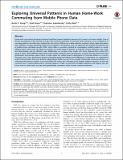| dc.contributor.author | Kung, Kevin S. | |
| dc.contributor.author | Greco, Kael | |
| dc.contributor.author | Sobolevsky, Stanislav | |
| dc.contributor.author | Ratti, Carlo | |
| dc.date.accessioned | 2014-09-11T18:57:49Z | |
| dc.date.available | 2014-09-11T18:57:49Z | |
| dc.date.issued | 2014-06 | |
| dc.date.submitted | 2013-11 | |
| dc.identifier.issn | 1932-6203 | |
| dc.identifier.uri | http://hdl.handle.net/1721.1/89450 | |
| dc.description.abstract | Home-work commuting has always attracted significant research attention because of its impact on human mobility. One of the key assumptions in this domain of study is the universal uniformity of commute times. However, a true comparison of commute patterns has often been hindered by the intrinsic differences in data collection methods, which make observation from different countries potentially biased and unreliable. In the present work, we approach this problem through the use of mobile phone call detail records (CDRs), which offers a consistent method for investigating mobility patterns in wholly different parts of the world. We apply our analysis to a broad range of datasets, at both the country (Portugal, Ivory Coast, and Saudi Arabia), and city (Boston) scale. Additionally, we compare these results with those obtained from vehicle GPS traces in Milan. While different regions have some unique commute time characteristics, we show that the home-work time distributions and average values within a single region are indeed largely independent of commute distance or country (Portugal, Ivory Coast, and Boston)–despite substantial spatial and infrastructural differences. Furthermore, our comparative analysis demonstrates that such distance-independence holds true only if we consider multimodal commute behaviors–as consistent with previous studies. In car-only (Milan GPS traces) and car-heavy (Saudi Arabia) commute datasets, we see that commute time is indeed influenced by commute distance. Finally, we put forth a testable hypothesis and suggest ways for future work to make more accurate and generalizable statements about human commute behaviors. | en_US |
| dc.language.iso | en_US | |
| dc.publisher | Public Library of Science | en_US |
| dc.relation.isversionof | http://dx.doi.org/10.1371/journal.pone.0096180 | en_US |
| dc.rights | Creative Commons Attribution | en_US |
| dc.rights.uri | http://creativecommons.org/licenses/by/4.0/ | en_US |
| dc.source | Public Library of Science | en_US |
| dc.title | Exploring Universal Patterns in Human Home-Work Commuting from Mobile Phone Data | en_US |
| dc.type | Article | en_US |
| dc.identifier.citation | Kung, Kevin S., Kael Greco, Stanislav Sobolevsky, and Carlo Ratti. “Exploring Universal Patterns in Human Home-Work Commuting from Mobile Phone Data.” Edited by Jose J. Ramasco. PLoS ONE 9, no. 6 (June 16, 2014): e96180. | en_US |
| dc.contributor.department | Massachusetts Institute of Technology. Department of Biological Engineering | en_US |
| dc.contributor.department | Massachusetts Institute of Technology. Department of Urban Studies and Planning | en_US |
| dc.contributor.department | Massachusetts Institute of Technology. SENSEable City Laboratory | en_US |
| dc.contributor.mitauthor | Kung, Kevin S. | en_US |
| dc.contributor.mitauthor | Greco, Kael | en_US |
| dc.contributor.mitauthor | Sobolevsky, Stanislav | en_US |
| dc.contributor.mitauthor | Ratti, Carlo | en_US |
| dc.relation.journal | PLoS ONE | en_US |
| dc.eprint.version | Final published version | en_US |
| dc.type.uri | http://purl.org/eprint/type/JournalArticle | en_US |
| eprint.status | http://purl.org/eprint/status/PeerReviewed | en_US |
| dspace.orderedauthors | Kung, Kevin S.; Greco, Kael; Sobolevsky, Stanislav; Ratti, Carlo | en_US |
| dc.identifier.orcid | https://orcid.org/0000-0003-2026-5631 | |
| dc.identifier.orcid | https://orcid.org/0000-0001-6281-0656 | |
| dc.identifier.orcid | https://orcid.org/0000-0001-7080-9196 | |
| mit.license | PUBLISHER_CC | en_US |
| mit.metadata.status | Complete | |
